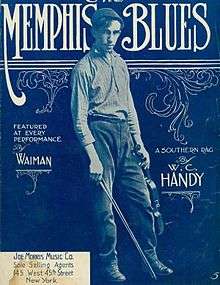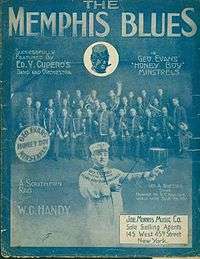The Memphis Blues
| "Memphis Blues" | |
|---|---|
| "Mr. Crump" | |
 Cover of "Memphis Blues" sheet music, 1912 | |
| Song by George Evans's "Honey Boys" Minstrels | |
| Published | 1912 |
| Form | Southern rag, blues, Memphis blues |
| Composer(s) | W. C. Handy |
| Lyricist(s) | George A. Norton |
| Language | English |
"The Memphis Blues" is a song described by its composer, W. C. Handy, as a "southern rag". It was self-published by Handy in September 1912 and has been recorded by many artists over the years.
"Mr. Crump"

Subtitled "Mr. Crump", "The Memphis Blues" is said to be based on a campaign song written by Handy for Edward Crump, a mayoral candidate in Memphis, Tennessee.[1] Handy claimed credit for writing "Mr. Crump", but Memphis musicians say it was written by Handy's clarinetist, Paul Wyer.[2] Many musicologists question how much "Mr. Crump" actually shared with "The Memphis Blues", since the words, taken from an old folk song, "Mama Don' 'low", do not match up with the melody of "The Memphis Blues".[3][4] Many think "Mr. Crump" was probably the same song as "Mr. Crump Don't Like It", later recorded by Frank Stokes of the Beale Street Sheiks (Paramont Race series, September 1927).[5]
New York
Handy first published the song as an instrumental. He immediately sold it to the music publisher Theron Bennett, who took it to New York to attempt to promote it. Handy later claimed he had been robbed.[6] In any case, Bennett convinced George "Honey Boy" Evans to use it for his "Honey Boy" Minstrels. Bennett hired a professional songwriter, George A. Norton, to write lyrics for it, and Evans had his director, Edward V. Cupero, arrange it for his band. Bennett published it a year later, but still the sheet music did poorly.[7] Bennett's 1913 publication advertises it as "Founded on W.C. Handy's World Wide 'Blue' Note Melody."[8]
Recordings
It wasn't until Victor Recording Company's house band (Victor Military Band, Victor 17619, July 15, 1914) and Columbia's house band (Prince's Band, Columbia A-5591, July 24) recorded the song in 1914 that "The Memphis Blues" began to do well.[9]
Harry James recorded a version in 1942 (released in 1944 as Columbia 36713).
References
- ↑ Komara, Encyclopedia of the Blues, p. 684: "It supposedly originated in a 1909 campaign song for Edward Crump, successful mayoral candidate in that year, later the long-time political boss of Memphis."
- ↑ Charters, The Country Blues, p. 39: "Older musicians said that it had been written by the orchestra's clarinet player, Paul Wyer."
- ↑ Komara, Encyclopedia of the Blues, p. 684.
- ↑ Charters, The Country Blues, p. 40.
- ↑ Cheseborough, Blues Travelling, p. 35.
- ↑ Charters, The Country Blues, p. 40: "Handy later complained bitterly that he was cheated out of the rights to his song, but the man who bought the rights from him was acting in good faith and had as little idea as Handy did the song would become so successful."
- ↑ Charters, The Country Blues, p. 40: "Discouraged by the lack of sales, he sold the plates and right for fifty dollars and a thousand unsold copies for another fifty dollars. the Memphis music-store owner who bought it managed to talk the famous minstrel man 'Honey Boy' Evans into using the piece in his New York engagement the next spring and engage a professional lyricist, George A. Norton, to write some words for it. It was republished in New York in the spring of 1913 with a picture of Evan's band on the cover and a note saying that the piece had been featured by the Famous Handy Orchestra of Memphis." "As a song, 'Memphis Blues' was more successful than it had been as the old instrumental piece, but it still was not a sensation. It became more popular as other blues were published, and by 1915 and 1916 was very well known."
- ↑ Hamm, Putting Popular Music in Its Place, p. 329: "Unlike folk and vocal blues, which usually consist of a string of 12-bar choruses, Handy's blues and other like them contain several contrasting strains. Both 'Memphis Blues' and 'St. Louis Blues' begin with a brief introduction, then contrast a strain in the 12-bar-blues form with another in the more standard 16-bar shape. To put it another way, commercialized blues of the 1910s and early 20s tend to have a 12-bar chorus embedded in a larger, multistrain structure."
- ↑ Tosches, Where Dead Voices Gather, p. 33: "The first recording of "The Memphis Blues," by the Victor Military Band on July 15 of 1914, used Cupero's arrangement. Another recording, by Prince's Orchestra for Columbia, followed nine days later, on July 24. Both were described in their respective catalogues as "one-step" dance songs, and both sold well. Handy's "Southern Rag," as overhauled by the author of "Melancholy Baby," as popularized by a minstrel troupe and recorded by a couple of white New York studio orchestras, became the first of the "blues" hits. To his credit, Handy, the former minstrel, was quick to acknowledge Honey Boy Evans's role in the song's success."
Bibliography
- Charters, Samuel B. (1975). The Country Blues. Da Capo Press. ISBN 0-306-70678-4.
- Cheseborough, Steve (2004). Blues Traveling: The Holy Sites of Delta Blues. University Press of Mississippi. ISBN 1-57806-650-6.
- Hamm, Charles (1995). Putting Popular Music in its Place. Cambridge University Press. ISBN 0-521-47198-2.
- Komara, Edward (2005). Encyclopedia of the Blues. Routledge. ISBN 0-415-92701-3.
- Tosches, Nick (2002). Where Dead Voices Gather. Back Bay Books. ISBN 0-316-89537-7.